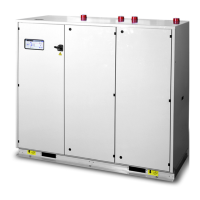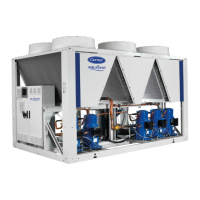5
1.4 - Repair safety considerations
All installation parts must be maintained by the personnel in
charge, in order to avoid material deterioration and injuries to
people. Faults and leaks must be repaired immediately. The
authorized technician must have the responsibility to repair the
fault immediately. Each time repairs have been carried out to
the unit, the operation of the safety devices must be re-checked.
If a leak occurs or if the refrigerant becomes polluted (e.g. by a
short circuit in a motor) remove the complete charge using a
recovery unit and store the refrigerant in mobile containers
(careful in case the refrigerant decomposes due to high tempera-
ture increases, as the decomposition products are dangerous).
If a leak occurs, evacuate all refrigerant, repair the leak detected
and recharge the circuit with the total R407C charge, as
indicated on the unit name plate. Never top up the charge. Only
charge liquid refrigerant R407C at the liquid line.
The 30RA 040 to 240 units use R407C refrigerant. These
units are essentially sold in Europe, and their operating
range is limited to an outside air temperature of approxi-
mately 45°C.
Always ensure you are using the correct refrigerant type
before recharging the unit.
Charging any refrigerant other than the original charge type
(R407C) will impair machine operation and can even lead to
a destruction of the compressors. The compressors operating
with R407C are charged with a synthetic polyolester oil.
R407C units have a hermetic refrigerant circuit and the
original charge needs not be topped up, as R407C is a
zeotropic refrigerant.
Do not use oxygen to purge lines or to pressurize a machine
for any purpose. Oxygen gas reacts violently with oil, grease,
and other common substances.
Never exceed the specified maximum operating pressures.
Verify the allowable maximum high- and low-side test pres-
sures by checking the instructions in this manual and the
pressures given on the unit name plate.
Do not use air for leak testing. Use only refrigerant or dry
nitrogen.
Do not unweld or flamecut the refrigerant lines or any refri-
gerant circuit component until all refrigerant (liquid and
vapour) has been removed from chiller. Traces of vapour
should be displaced with dry air nitrogen. Refrigerant in
contact with an open flame produces toxic gases.
The necessary protection equipment must be available, and
appropriate fire extinguishers for the system and the
refrigerant type used must be within easy reach.
Do not siphon refrigerant.
1.3 - Maintenance safety considerations
Engineers working on the electric or refrigeration components
must be authorized and fully qualified to do so (electricians
trained and qualified in accordance with IEC 60364 Classi-
fication BA4).
All refrigerant circuit repairs must be carried out by a trained
person, fully qualified to work on these units. He must have
been trained and be familiar with the equipment and the
installation, and he must wear the necessary protective items
(gloves, glasses, protective clothes, safety shoes).
Soldering and welding: Component, piping and connection
soldering and welding operations must be carried out using the
correct procedures and by qualified operators. Pressurised
containers must not be subjected to shocks, nor to large
temperature variations during maintenance and repair operations.
Never work on a unit that is still energized.
Never work on any of the electrical components, until the
general power supply to the unit has been cut using the
disconnect switch in the control box.
If any maintenance operations are carried out on the unit,
lock the power supply circuit in the open position ahead of
the machine.
If the work is interrupted, always ensure that all circuits are
still deenergized before resuming the work.
ATTENTION: Even if the unit has been switched off, the
power circuit remains energized, unless the unit or circuit
disconnect switch is open. Refer to the wiring diagram for
further details. Attach appropriate safety labels.
Operating checks: During the life-time of the system,
inspection and tests must be carried out in accordance with
national regulations.
The information on operating inspections given in annex C of
standard EN378-2 can be used if no similar criteria exist in
the national regulations.
Safety device checks (annex C6 – EN378-2): The safety
devices must be checked on site once a year for safety devices
(high-pressure switches), and every five years for external
overpressure devices (safety globe valves).
Contact Carrier Service for a detailed explanation of the
high-pressure switch test method.
If the machine operates in a corrosive environment, inspect
the protection devices more frequently.
Regularly carry out leak tests and immediately repair any leaks.

